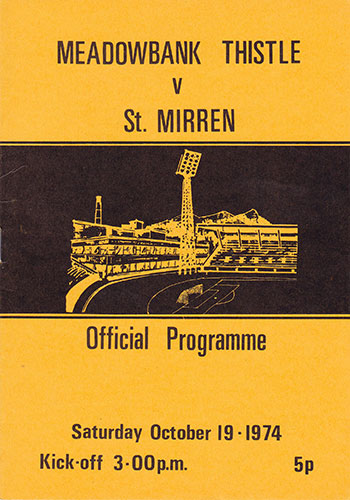Managerless Saints beat the League New Boys - 1974
(first published in the match programme for St. Mirren v Livingston, 20th November 2021)
From the mid-1950s, the Scottish League had been operating with an odd number of teams, leading to each of the Second Division sides having two blank weekends during the course of the season. The inclusion of Clydebank in 1966/67 to round up the numbers was unfortunately negated by the demise of Third Lanark at the end of the same season. With major League reconstruction scheduled for the start of the 1975/76 season, the situation had to be resolved. In May 1974, the Scottish League considered a number of applications, resulting in East of Scotland League side Ferranti Thistle being voted in as its new, thirty-eighth member club.

Meadowbank Thistle v St. Mirren 1974
Before they could finalise their place however, the 21-year old works side from the Edinburgh engineering firm were asked by the League Management Committee to change their name. This was necessary to dispel concerns from the pools companies, who paid for use of the football fixtures, as they were unhappy about the use of a commercial name for a football club. The Club were also forced to relocate from their current home - Edinburgh City's old City Park - and were offered the use of Meadowbank Stadium. The new venue had been constructed for the 1970 Commonwealth Games but, with only one stand and an athletics track surrounding the pitch, it was hardly ideal for the football spectator. On taking up the offer, the Club changed its name to Meadowbank Thistle.
St. Mirren were without a manager when they travelled through to the capital to play the new side for the first time on 19th October 1974. Willie Cunningham had resigned at the beginning of the week following three disappointing League results which had contributed to Saints' drop from first place to eighth in the space of six matches. Thistle, on the other hand, had achieved their first-ever League win with a 1-0 victory at Brechin on the previous Saturday.
In front of 846 spectators, Tony Fitzpatrick gave the visitors the lead after 10 minutes, but Jim Hancock got Meadowbank's equaliser nine minutes later. Midway through the second half, Brian Third fired in two goals in the space of two minutes to give Saints a 3-1 lead. Despite Les McVay's counter for the home side late on, Alan Hughes netted with two minutes remaining to give St. Mirren a 4-2 victory.
The Meadowbank programme for their first season in the League was an A5-sized issue costing 5p and consisting of an amber card cover overprinted in black, enclosing four pages of text printed black on white paper. The front cover displayed the team names and date and time of the match above and below a line drawing of Meadowbank Stadium.
Page two carried a heading of Club Officials above the manager s welcome in Bain s Bulletin . Opposite this, the fixtures for the season were presented above a selected Player Profile, the player chosen for the St. Mirren issue being 20-year-old Derek Fotheringham. The centre pages listed the player pools of both sides and the match officials, surrounded by adverts from local traders.
"Our Visitors" headed page six and reviewed St. Mirren's results thus far, and commented on the departure of the visiting side's manager and the recent sale of Bobby McKean to Rangers. The League newcomers hoped that the boost in confidence from their victory the week before would help them grab both points.
The modest issue concluded with an advert for Meadowbank Sports Centre on page seven and a photo of the home squad on the back page.
This Meadowbank programme falls into a popular category amongst programme collectors; that of "First and Last season" issues. The increased interest in such programmes, combined with their generally low print runs, mean that they can be difficult to obtain. As a consequence, they can command prices far in excess of their face value.
On the Monday after the match, St. Mirren appointed Alex Ferguson as their new Manager. The rest, they say, is history.

